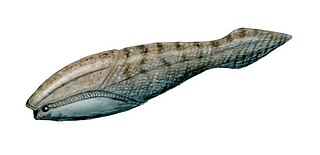
Arandaspida is a taxon of very early, jawless prehistoric fish which lived during the Ordovician period. Arandaspids represent the oldest known craniates, a proposed group of chordates that contain all chordates with a cartilage-derived skull, and hagfish. The group represents a subclass within the class Pteraspidomorphi, and contains only one order, the Arandaspidiformes. The oldest known genus of this group is Sacabambaspis found in South America.

Heterostraci is an extinct subclass of pteraspidomorph jawless vertebrate that lived primarily in marine and estuary environments. Heterostraci existed from the mid-Ordovician to the conclusion of the Devonian.

Psammosteidae is an extinct family of flattened, benthic heterostracan vertebrates that lived in marine and estuary environments in Europe, Russia & North America. They arose during the Early Devonian, with the first known genus, Drepanaspis from the Hunsrück lagerstätte. The Psammosteids were the only heterostracans that survived the Upper Frasnian extinction event during the Late Devonian, dying out in the extinction event at the very end of the Devonian.
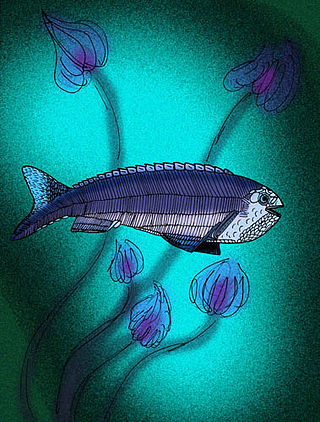
Anaspida is an extinct group of evolutionarily underived jawless vertebrates that existed from the early Silurian period to the late Devonian period. They were classically regarded as the ancestors of lampreys. Anaspids were small marine agnathans that lacked a heavy bony shield and paired fins, but were distinctively hypocercal.
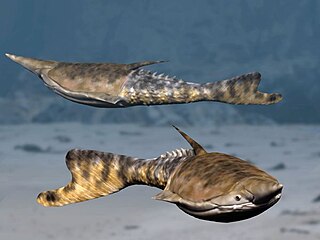
Pteraspidomorphi is an extinct class of early jawless fish. They have long been regarded as closely related or even ancestral to jawed vertebrates, but the few characteristics they share with the latter are now considered as basal traits for all vertebrates.
Eriptychiida is an extinct marine taxon of vertebrate in the group Pteraspidomorphi.

Pteraspis is an extinct genus of pteraspidid heterostracan agnathan vertebrate that lived from the Lochkovian to Eifelian epochs of the Devonian period in what is now Brazil, Britain, Ukraine and Belgium.

Doryaspis is an extinct genus of primitive jawless fish that lived in the Devonian period. Fossils have been discovered in Spitsbergen.

Drepanaspis is an extinct genus of primitive jawless Ostracoderms from the Early Devonian that belonged to the phylum Chordata, infraphylum Agnatha, class Pteraspidomorphi, and the subclass Heterostraci. Drepanaspis are assumed to have lived primarily in marine environments and is most commonly characterized by their ray-like, heavily armored bodies, along with their lack of paired fins and jaws.

The Bagridae are a family of catfish that are native to Africa (Bagrus) and Asia from Japan to Borneo. It includes about 245 species. These fish are commonly known as naked catfishes or bagrid catfishes.
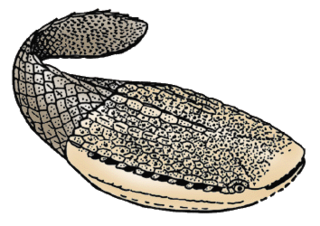
Astraspida, or astraspids, are a small group of extinct armored jawless vertebrates, which lived in the Middle Ordovician in North America. They are placed among the Pteraspidomorphi because of the large dorsal and ventral shield of their head armor. They are represented by a single genus, Astraspis, including possibly two species, A. desiderata and A. splendens but their remains are fairly abundant in Ordovician sandstones of the USA and Canada (Quebec). The head armor of Astraspis is rather massive, with a series of ten gill openings lining the margin of the dorsal shield, and laterally placed eyes. The dorsal shield is ribbed by strong longitudinal crests, and the tail is covered with large, diamond-shaped scales. They are often grouped together with the Arandaspidida.

A grapefruit knife is a special type of knife designed specifically for cutting grapefruit. Grapefruit knives are small with a curved serrated blade, designed to hug the curves of the grapefruit. This is used to separate the outer edge of the segments from the rim of the fruit. The term "grapefruit knife" can refer to a type of knife with short, serrated twin blades about 2mm apart, used to separate the sides of each section from the dividing membrane. Some grapefruit knives incorporate both types, a double-sided curved blade on one side and the parallel twin blades on the other. Another type includes an angled tip and double sided serrated blade. When both types are used, the result is an intact-looking fruit with sections which lift out easily - especially if a "grapefruit spoon" is used.

Parabradysaurus is an extinct genus of estemmenosuchid dinocephalians. It is known from a few serrated teeth that indicate this animal was like herbivorous.

Protopteraspis is an extinct genus of pteraspidid heterostracan agnathan with fossils known from Lower Devonian marine strata in Western Europe. The animal's somewhat flat build has led some to believe that it was a bottom dweller, living in freshwater areas. It has been described as "somewhat unspecialized". Its snout was round and narrow, shorter than that of its immediate relatives. Protopteraspis also did not possess the cornua (horns) found on the headshields of other pterapsids; rather, it had "small points" behind the gill opening. It did possess a "medium-sized" dorsal spine. Plates covering the headshield had ridges of dentine. It is theorized that the headshield formed in youth and that it grew via growth of the plates, which fused in adulthood. The scales of the animal were "small and diamond shaped".

Pteraspidiformes is an extinct order of heterostracan agnathan vertebrates known from extensive fossil remains primarily from Early Devonian strata of Europe and North America, and from Upper Silurian Canada.

Cyathaspidiformes is an extinct order of heterostracan vertebrates known from extensive fossil remains primarily from Silurian to Early Devonian strata of Europe, and North America, and from Early Devonian marine strata of Siberia.
Edaphaspis bystrowi is an extinct amphiaspidid cyathaspidid heterostracan. Its fossils are restricted to early Devonian-aged marine strata of the Taimyr Peninsula, Early Devonian Siberia. E. bystrowi, as with all other amphiaspidids, is thought to have been a benthic filter feeder that lived on top of, or buried just below the surface of the substrate of hypersaline lagoon-bottoms. It is the only representative of the family Edaphaspididae.

Olbiaspididae is a family of extinct amphiaspidid heterostracan agnathans whose fossils are restricted to Lower Devonian marine strata of Siberia near the Taimyr Peninsula. In life, all amphiaspidids are thought to be benthic animals that lived most of their lives mostly buried in the sediment of a series of hypersaline lagoons. Amphiaspids are easily distinguished from other heterostracans in that all of the plates of the cephalothoracic armor are fused into a single, muff-like unit, so that the forebody of the living animal would have looked, in the case of olbiaspidids, vaguely like a hot water bottle with a pair of small, or degenerated eyes, with each flanked by a preorbital opening, and a simple, slit-like mouth positioned at the anteriormost portion of the cephalothoracic armor.
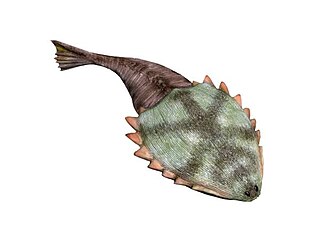
Hibernaspis is a genus of extinct amphiaspidid heterostracan agnathans whose fossils are restricted to Lower Devonian marine strata of Siberia near the Taimyr Peninsula. In life, species of Hibernaspis were thought to be benthic animals that lived most of their lives mostly buried in the sediment of a series of hypersaline lagoons. All amphiaspids are easily distinguished from other heterostracans in that all of the plates of the cephalothorax armor are fused into a single, muff-like unit, so that, in the case of Hibernaspis, the forebody of the living animal would have looked like a large guitar pic with serrated edges, with a pair of tiny, degenerated eyes, a pair of branchial openings for exhaling, and a simple, slit-like mouth at the anterior end.
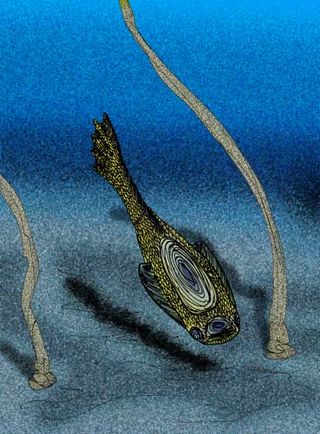
Weigeltaspis is a genus of extinct heterostracan agnathan fish known from the Late Silurian and Early Devonian periods. Fossils are known primarily from Early Devonian-aged marine strata of Europe and Canada. Fragments and disarticulated plates of what may be of Weigeltaspis are known from Late Silurian-aged marine strata of Arctic Canada. Rare articulated fossils, plus the overall anatomy of its plates suggest the living animals were, at least superficially, similar to psammosteids, some authorities, such as Tarlo, place them within Psammosteida. Because the ornamentation on the plates and scales are very similar to the ornamentation seen on the plates and scales of Traquairaspis to the point of constant confusion, other authorities follow the lead of Obruchev, and place Weigeltaspis within Traquairaspidiformes. Still other authorities remain unconvinced of either side, and, instead, follow Denison's lead to simply treat Weigeltaspis as incertae sedis.


















